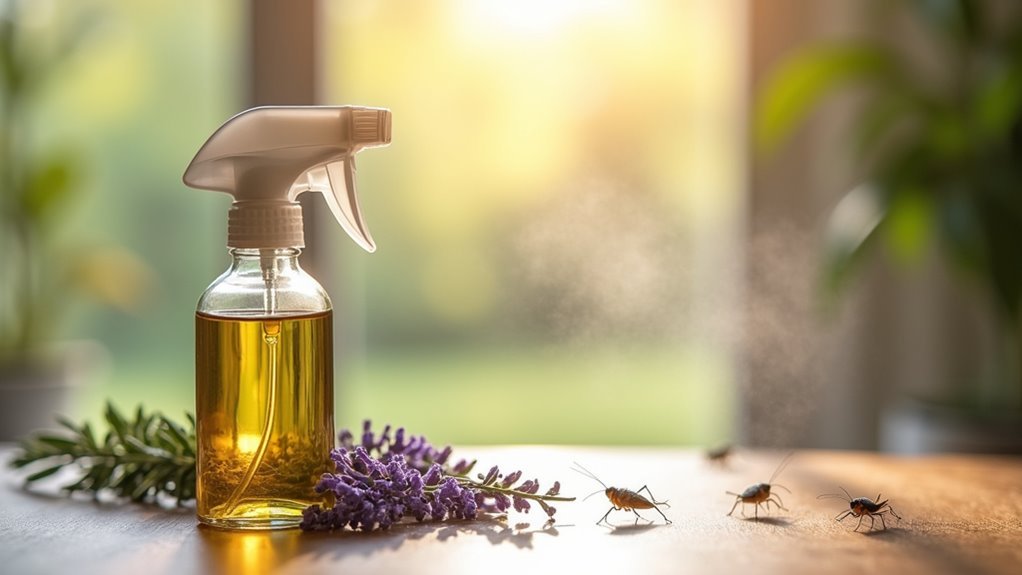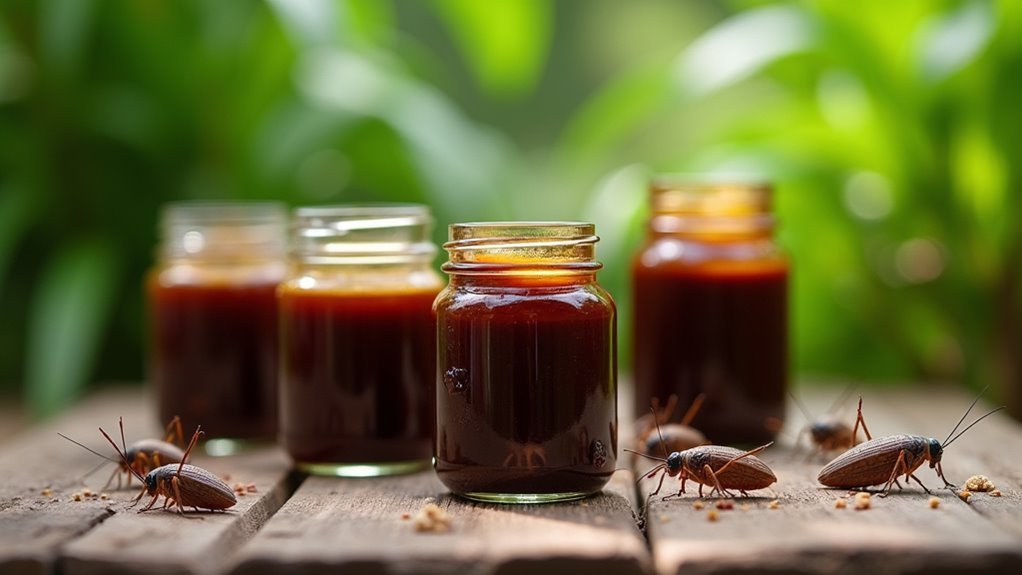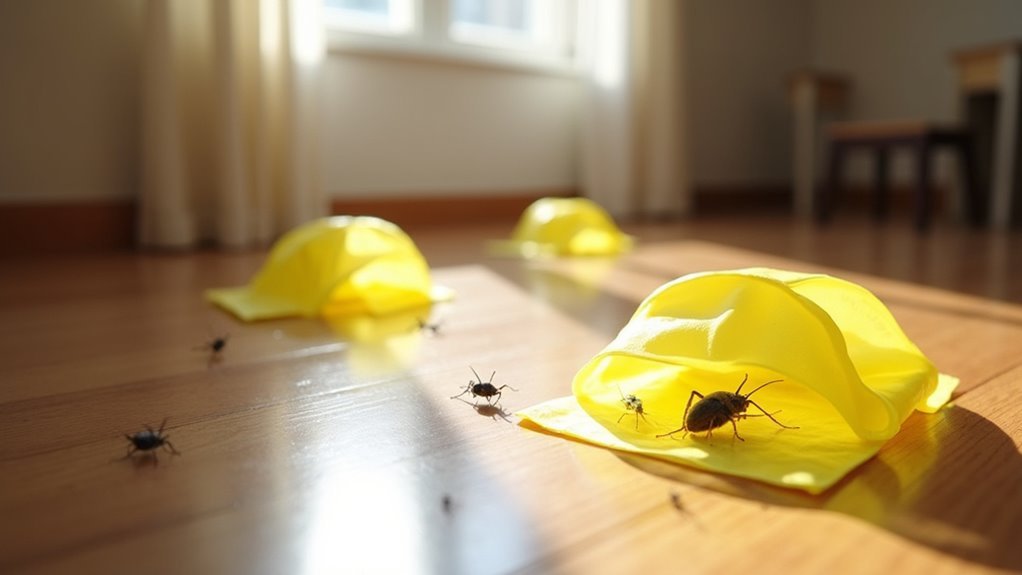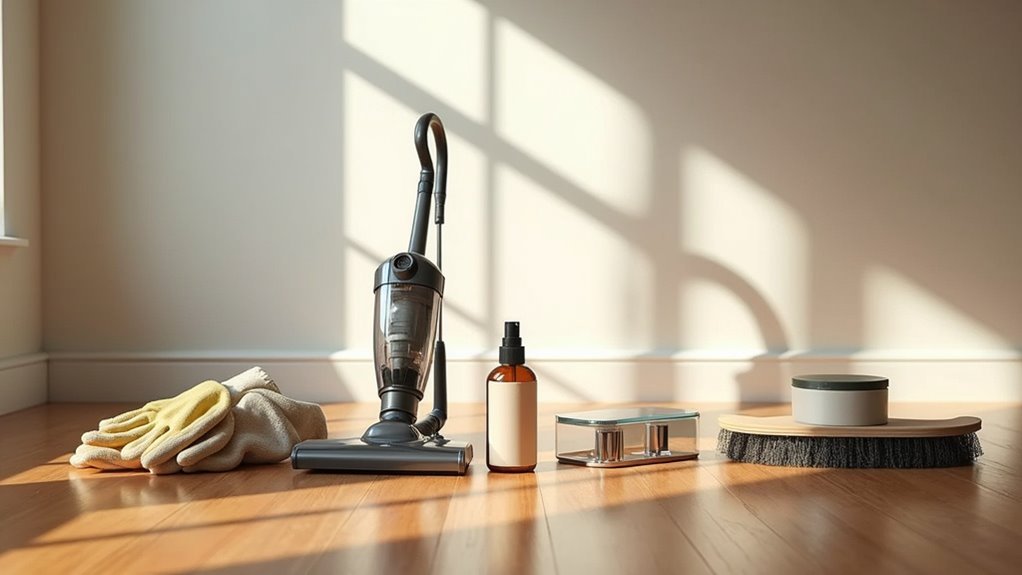You can eliminate indoor crickets using seven proven methods: spray peppermint essential oil mixed with water around entry points, apply food-grade diatomaceous earth in hiding spots, set molasses traps with sweet bait, vacuum cricket areas at night when they’re active, place sticky traps in dark corners, encourage natural predators like cats, and seal gaps with caulk while removing moisture sources. These techniques target both existing populations and prevention strategies for thorough cricket control.
Use Essential Oil Sprays to Repel Crickets

When crickets invade your home, essential oil sprays offer a natural and effective solution that won’t harm your family or pets.
Peppermint essential oil stands out as the most powerful cricket deterrent due to its potent scent that crickets can’t tolerate.
Create your cricket-repelling spray by mixing 10-15 drops of peppermint essential oil with 2 cups of water in a spray bottle.
Target areas where crickets typically hide, including under sinks, around windows, and entry points to your home.
This non-toxic alternative effectively drives crickets away without exposing children and pets to harmful chemicals.
Regular application maintains effectiveness and prevents crickets in your home from returning.
Essential oils naturally repel crickets while keeping your living spaces safe and chemical-free.
Apply Diatomaceous Earth in Cricket Hiding Areas
Beyond natural repellents, diatomaceous earth offers a more permanent solution that eliminates crickets rather than simply driving them away. This natural insecticide made from fossilized aquatic organisms dehydrates crickets upon contact. Always use food-grade DE, as it’s safe to use around children and pets.
Apply DE as a thin layer in cricket hiding areas like under sinks and along baseboards. Thick applications create barriers crickets can avoid. Since moisture renders DE ineffective against insects, only apply in dry areas and reapply after cleaning.
| Application Area | DE Amount | Reapplication |
|---|---|---|
| Baseboards | Light dusting | After dampness |
| Under sinks | Thin layer | Weekly check |
| Dark corners | Minimal coating | Monthly refresh |
| Entry points | Fine sprinkle | As needed |
Regular monitoring guarantees you’ll effectively control cricket population.
Create Molasses Traps to Capture Crickets

As diatomaceous earth works through direct contact, molasses traps offer a complementary approach that lures crickets to their demise.
To create molasses traps, mix three tablespoons of molasses with two cups of water in a jar or container. The sweet scent will attract crickets effectively.
Position these traps in areas where you’ve spotted cricket activity, particularly under sinks and near entry points. Leave jars open so crickets can easily jump inside and drown in the mixture. This natural and simple method helps capture crickets without using harmful chemicals.
Perform regular checks to replace the molasses mixture, maintaining its effectiveness. Since it’s safe for homes with children and pets, you can confidently use this approach to reduce cricket populations throughout your house.
Vacuum Cricket Hiding Spots and Entry Points
While molasses traps work well for luring crickets out into the open, vacuuming provides an immediate and direct method to eliminate both visible crickets and their hidden populations.
Use a hose attachment to reach cricket hiding spots under appliances and along baseboards where adults and eggs accumulate. Focus on damp corners where crickets seek shelter, as these dark areas are their preferred locations.
Vacuum entry points and areas where you hear chirping, indicating active populations. Night vacuuming proves most effective since crickets emerge from hiding when they’re most active.
After each session, immediately dispose of vacuum contents to prevent escapes. Regular vacuuming of these targeted areas will help you remove existing crickets and prevent infestations from establishing in your home.
Place Sticky Traps in High Activity Areas

You’ll want to strategically position sticky traps where crickets spend most of their time to maximize your capture success.
Focus on enhancing each trap’s appeal through simple techniques that draw more crickets to the adhesive surface.
Monitor your traps regularly to track results and maintain their peak effectiveness throughout your cricket removal efforts.
Optimal Trap Placement
Three key factors determine successful cricket capture: location, timing, and strategic placement of your sticky traps.
You’ll maximize capture rates by positioning traps in dark corners, under sinks, and behind appliances where crickets congregate. Focus on entry points like doors and windows to intercept crickets before they spread throughout your home.
Monitor activity levels regularly to identify high-traffic areas and adjust your ideal trap placement accordingly. For significant infestations, use multiple traps in single locations to increase effectiveness.
Place traps flat against surfaces and check weekly to prevent overcrowding. Replace them when they’re full or lose adhesiveness.
Strategic positioning combined with consistent monitoring guarantees you’ll capture more crickets efficiently.
Enhancing Trap Effectiveness
Strategic placement based on cricket activity patterns dramatically increases your trap success rates.
You’ll enhance attractiveness and capture crickets more effectively by following proven techniques that intercept crickets before they establish hiding spots.
Position sticky traps strategically to monitor traps across a larger area while maximizing effectiveness:
- Use dead crickets as bait – Place deceased crickets on traps to enhance attractiveness through natural pheromones that lure additional crickets to the area.
- Deploy multiple traps near entry points – Position several sticky traps around doors, windows, and basement entrances to intercept crickets entering your home and increase likelihood of capture.
- Replace traps regularly – Monitor traps frequently and replace them when full or after one week to maintain peak effectiveness and prevent cricket avoidance.
Monitoring Trap Results
Where should you place sticky traps to maximize cricket capture rates? Target areas where you’ve frequently observed or heard crickets, including basements, kitchens, and dark corners.
This strategic monitoring approach helps track cricket activity levels effectively.
Check your traps regularly to document capture results and identify high-activity zones. These findings inform your targeted control efforts and improve overall efficiency.
Position traps near entry points and hiding spots like under sinks or behind appliances to boost capture rates.
Replace traps every few weeks to maintain their effectiveness. Document your results over time to recognize patterns in cricket activity.
This data helps you develop a thorough pest management strategy that addresses problem areas systematically, making your control efforts more strategic and successful.
Utilize Natural Predators Like Cats and Dogs
One of the most effective and natural approaches to cricket control involves harnessing your pets’ innate hunting abilities.
Cats and dogs are natural predators that can appreciably reduce population levels in your indoor environment. Their presence alone deters crickets, while their hunting instincts help track and catch these pests effectively.
To maximize your pets’ cricket-hunting potential:
- Encourage active playtime to engage their stalking behaviors and make them more alert to cricket movements in hiding spots.
- Allow supervised exploration of areas where you’ve noticed cricket activity, letting their natural behaviors disrupt pest habitats.
- Install outdoor bird feeders to attract cricket-eating birds, creating a balanced ecosystem around your home.
This approach creates a pest-free environment while reducing infestation risks naturally.
Seal Entry Points and Remove Cricket Attractants
While natural predators can greatly reduce cricket populations, preventing these pests from entering your home in the first place proves even more effective.
Seal entry points around doors, windows, and foundations using caulk or weatherstripping to block cricket access. Remove cricket attractants by eliminating moisture sources like leaky pipes and high humidity areas, since crickets thrive in warm, damp conditions.
Block cricket entry by sealing gaps with caulk and eliminating moisture from leaky pipes and humid areas where they flourish.
Keep food sealed properly, especially pet food, which draws crickets indoors. Declutter storage areas regularly to eliminate hiding spots and maintain an environment that discourages infestations.
Outside your home, maintain a well-trimmed lawn and remove debris to limit outdoor habitats. These preventive measures work together to prevent crickets from establishing themselves near and inside your living spaces.
Frequently Asked Questions
How Do You Get Rid of Indoor Crickets?
You’ll eliminate indoor crickets by setting molasses traps, sprinkling diatomaceous earth in their paths, spraying peppermint oil around entry points, placing sticky traps strategically, and vacuuming regularly to remove adults and eggs.
How Do You Draw a Cricket Out of Hiding?
You’ll draw crickets from hiding by placing sweet baits like molasses or cereals near their spots. Use essential oil sprays around hiding areas, reduce clutter, and maintain cleanliness to force them into open spaces.
How Do I Shut up Cricket in My House?
You’ll silence chirping crickets by spraying peppermint oil mixed with water in their hiding spots, setting molasses traps, vacuuming regularly, and sealing cracks around doors and windows to prevent new ones entering.
What Do Crickets Hate the Most?
You’ll find crickets absolutely hate strong scents like peppermint, lemon juice, and lavender. They also can’t stand spicy aromas from chili powder, crushed garlic, and musk-based cleaners that create unbearable environments.
In Summary
You’ve got several effective options to eliminate indoor crickets. Start with essential oils and diatomaceous earth for immediate results, then set up molasses and sticky traps in problem areas. Don’t forget to vacuum thoroughly and let your pets help with the hunt. Most importantly, you’ll need to seal entry points and remove what’s attracting them in the first place. Combine these methods for the best cricket-free results.





Leave a Reply